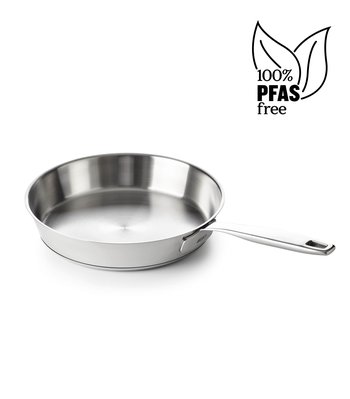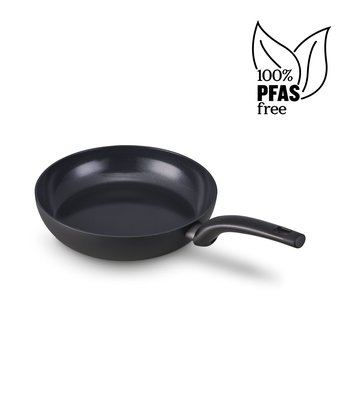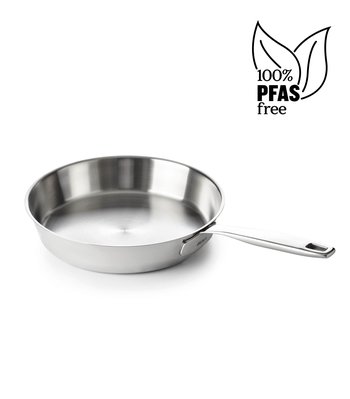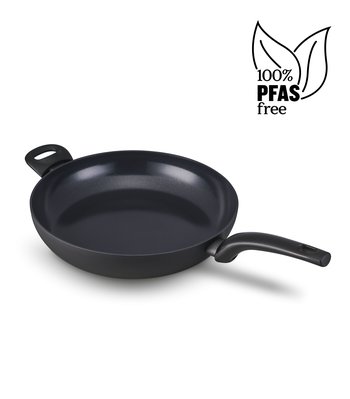Frying pans in different materials - How to choose the pan that's right for you
Which frying pan is best, the one made of stainless steel or aluminium? Do I go for non-stick or not? In short: go for both! Because, depending on what you are cooking, one pan is more suitable than the other. Learn what to look out for when buying new pans in this frying pan guide.

Shopping for pans for your kitchen? It may sound simple but you need some information before you go shopping. There are plenty of materials and finishes available in the pan department. Which one you need depends on what you want to cook and how you will prepare it.
Let's dive into the two most popular materials for frying pans: stainless steel and aluminium.
.png)
Why choose a stainless steel (SS) pan?
Because it’s just what you need in terms of durability. Not only are stainless steel pans strong and remain perfectly stable on any hob type for years, they are also resistant to all types of ingredients and detergents.
The inside is neutral in terms of smell and taste and can really take a beating. So there’s no need to worry about using metal utensils in your pan or flavours from your equipment mingling with your ingredients. Moreover, in terms of cleaning, they are child's play: from a scouring pad to a dishwasher, stainless steel pans without a non-stick coating tolerate it all.
Not all stainless steel pans distribute heat equally well.
Thanks to the strength of the material, stainless steel does not wear out quickly and tolerates high temperatures extremely well. The only weakness of pure stainless steel is its lower heat conduction. That is why the bases of stainless steel pots and pans are coated with an aluminium layer between the stainless steel inner and outer surfaces. Thus, the base of almost all stainless steel pans consists of 3 layers: a triple-encapsulated base, or 'sandwich bottom'. This extra aluminium layer between stainless steel ensures better and faster heat conduction.
.jpg)
Is optimal heat conduction, all the way to the edge, crucial for you? For example, do you like to prepare gravy or sauce in the pan after frying? Then we recommend another type of stainless steel pan, the ‘multi-ply pan’. These pans are made of stainless steel with an extra layer or multiple layers of aluminium not only in the base but between all edges. Multi-ply thus stands for 'multiple layers'. Beka has several frying pans in its range with 3-ply as well as 5-ply. The more layers, the better the heat conduction and solidity of your pan.
.png)
What do you prepare in a plain stainless steel pan?
Stainless steel pans are hugely versatile to use. The type without non-stick or coating is 100% chemical-free.
But since the risk of sticking is higher with stainless steel pans without non-stick coating, it is important to make the pan sufficiently hot before putting the ingredients in the pan. Once the pan is hot, a stainless steel frying pan becomes the perfect go-to for preparing red meat, such as steak, or poultry.
As its placed in the hot pan, a steak will stick to the bottom. A few seconds later, once the meat starts searing, it will loosen by itself. The result of frying in a hot stainless steel pan is a tender preparation with a deliciously browned crust!
It is better to fry eggs or breaded ingredients in a pan with a non-stick coating. These can be made of stainless steel or aluminium.
Why is aluminium so popular for frying pans?
The biggest advantage of aluminium pans is simple; faster meals with less sticking. But there is more to an aluminium non-stick pan:
Compared to stainless steel pans, aluminium pans can be up to half the weight so much less effort is required to manoeuvre aluminium pans during cooking and cleaning.
Aluminium is also known for its excellent heat distribution. It conducts heat more than 10 times faster and more evenly than a stainless steel frying pan. Aluminium pans thus heat up and cool down faster.
.jpg)
.png)
Is every aluminum pan a non-stick pan?
Yes! An obvious plus side to aluminium frying pans: they come with a non-stick coating as standard. It goes without saying that there will be less sticking with non-stick pans, so you need less fat when frying and washing up is a breeze.
Downside: The lifespan of aluminium pans is lower than the stainless steel variant; the lightweight material is less durable. Not handling the pan carefully will cause the material to bend or dent quickly, and the non-stick coating in particular can be damaged by misuse.
Three key factors to extend the life of any non-stick coating: only clean by hand, never cook at high temperatures and do not use metal forks or kitchen utensils. These are simple adjustments that will make your non-stick pan last even longer.
So which non-stick pan should I buy?
The two most common types of non-stick coatings are the 'classic' PTFE coatings and the newer ceramic non-stick coatings.
For years, the standard among non-stick coatings was based on the well-known Teflon. This type of coating comes in different variants (platinum, reinforced with diamonds, etc.): some are slightly stronger than others, but all work on the same basis. The big advantage for cooks lies in being able to fry with less fat, without any sticking. Less oil and butter with a delicious result: sounds good! To this day, the non-stick properties of this PTFE coating are the best on the market.
.png)
The main advantage of the more recent 'ceramic non-stick' coating lies in its strength, temperature and scratch resistance. This coating is made of materials found in nature such as stone and sand. Ceramic non-stick coatings, therefore, have a better impact on nature and the environment compared to a Teflon variant.
.png)
When is a non-stick coating ideal?
As mentioned earlier, a stainless steel pan without a non-stick coating is recommended for frying red meat or poultry. For more delicate dishes such as breaded ingredients, fish, eggs and vegetables, we recommend a non-stick pan.
Non-stick pans function best on low to medium heat. The excellent heat conductivity of the aluminium means that is sufficient for these more delicate preparations. Moreover, avoiding the highest temperatures will improve the durability of your non-stick coating.
Good to know! Always use a little oil or butter, even with non-stick pans. Heating or frying pans without fat, also known as dry frying, is not good for your non-stick coating. This will trap heat in the non-stick coating, which can cause the coating to overheat and get damaged.
Options besides Teflon and ceramic non-stick coating?
You can also choose pans where you create your own natural non-stick coating. Slightly less well-known, but certainly just as good, is the carbon steel pan. This pan can be seasoned with oil, creating a natural non-stick coating that strengthens with frequent use. With the right care, you then get the ideal pan. Ideal for the amateur chefs among us.
Made a choice? Find the right pan at Beka!
Stainless steel or aluminium? Non-stick or not? Beka offers all types of frying pans!
Now to decide which size suits you best. Do you usually prepare large meals? Then go for a pan with an extra grip. Our largest frying pans have a long handle on one side and a short handle on the other, so you can cook up a storm in the kitchen.
Still no idea which one to choose? Beka's Product Wizard to the rescue. Using our short test, you can tell us all about your cooking habits and preferences and we'll tell you which pan is right for you.








